
Exile is a series of role-playing video games created by Jeff Vogel of Spiderweb Software. They were released as shareware titles for Macintosh and Windows systems. Exile III was also ported to Linux by a third party. There were four games released in the series. All of the games were later revived in the Avernum series. Common to all games in the Exile series are 2D graphics and basic sound. The graphics in the first versions of Exile I and II had simple textures, colours and outlines, which were then replaced in later versions with Exile III's graphics. The games are designed to be non-linear and long in gameplay length.
Shareware is a type of proprietary software that is initially shared by the owner for trial use at little or no cost. Often the software has limited functionality or incomplete documentation until the user sends payment to the software developer. Shareware is often offered as a download from a website. Shareware differs from freeware, which is fully-featured software distributed at no cost to the user but without source code being made available; and free and open-source software, in which the source code is freely available for anyone to inspect and alter.
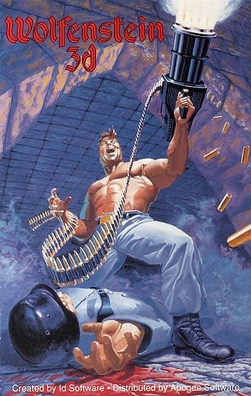
Wolfenstein 3D is a first-person shooter video game developed by id Software and published by Apogee Software and FormGen. Originally released on May 5, 1992, for DOS, it was inspired by the 1981 Muse Software video game Castle Wolfenstein, and is the third installment in the Wolfenstein series. In Wolfenstein 3D, the player assumes the role of Allied spy William "B.J." Blazkowicz during World War II as he escapes from the Nazi German prison Castle Wolfenstein and carries out a series of crucial missions against the Nazis. The player traverses each of the game's levels to find an elevator to the next level or kill a final boss, fighting Nazi soldiers, dogs, and other enemies with a knife and a variety of guns.
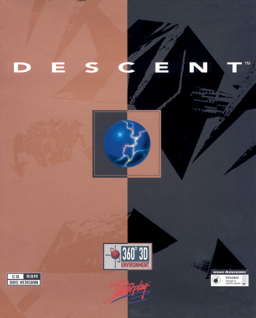
Descent is a first-person shooter (FPS) game developed by Parallax Software and released by Interplay Productions in 1995 for MS-DOS, and later for Macintosh, PlayStation, and RISC OS. It popularized a subgenre of FPS games employing six degrees of freedom and was the first FPS to feature entirely true-3D graphics. The player is cast as a mercenary hired to eliminate the threat of a mysterious extraterrestrial computer virus infecting off-world mining robots. In a series of mines throughout the Solar System, the protagonist pilots a spaceship and must locate and destroy the mine's power reactor and escape before being caught in the mine's self-destruction, defeating opposing robots along the way. Players can play online and compete in either deathmatches or cooperate to take on the robots.
Spiderweb Software is an independent video game developer founded in 1994 by Jeff Vogel in Seattle, Washington. Its primary focus is on creating demoware games for the Mac, Microsoft Windows, Android and the iPad. The games emphasize storytelling and turn-based gameplay and use a retro style of graphics.
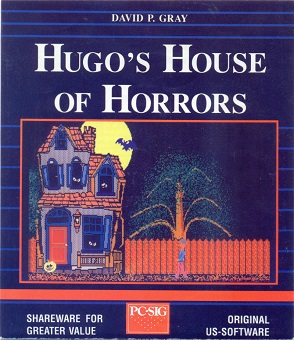
Hugo's House of Horrors is a parser-based adventure game designed by independent software developer David P. Gray and published as shareware in 1990. The game follows the character Hugo as he searches for his girlfriend Penelope in a haunted house. To progress through the game, the player uses items and interacts with the environment to solve puzzles and access more rooms in the house. The gameplay was inspired by Leisure Suit Larry in the Land of the Lounge Lizards. Hugo's House of Horrors was praised for its environment and atmosphere, but was criticized for its plot and visual design. It was followed by two sequels: Hugo II, Whodunit? and Hugo III, Jungle of Doom!, and a spin-off first-person shooter game, Nitemare 3D.
VGA Planets is a multi-player space strategy war game originally released in 1992. The game simulates combat in space between galactic scale empires. It follows the 4X game model: The players start with a home world, and have to build spaceships, explore the galaxy, colonize planets, mine minerals, build up their industry.
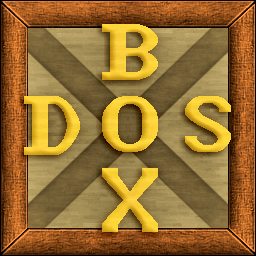
DOSBox is a free and open-source emulator which runs software for MS-DOS compatible disk operating systems—primarily video games. It was first released in 2002, when DOS technology was becoming obsolete. Its adoption for running DOS games is widespread, with it being used in commercial re-releases of those games as well.

Jazz Jackrabbit 2 is a 1998 platform game produced by Epic MegaGames. It was released for Windows, and later for Macintosh. Like the first game, Jazz Jackrabbit, Jazz Jackrabbit 2 is a side-scrolling platform game but features additional multiplayer options, including the ability to play over a LAN or the Internet. The game was re-released on GOG.com along with the first game on November 30, 2017.

Raptor: Call of the Shadows is a vertically scrolling shooter developed by Cygnus Studios and published by Apogee Software. Its working title was "Mercenary 2029". It was released on April 1, 1994 for MS-DOS compatible systems. The first episode of the game, "Bravo Sector", was distributed as shareware, while the other two episodes were sold commercially.
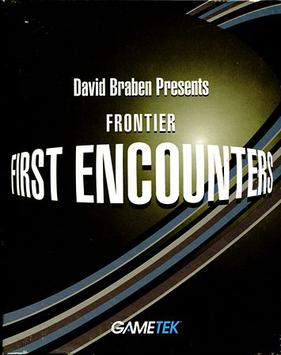
Frontier: First Encounters is a 1995 space trading and combat simulator video game developed by Frontier Developments and published by GameTek for DOS. The player pilots a spaceship through a universe pursuing trading, combat and other missions.

Terminal Velocity is a shooter video game originally developed by Terminal Reality and published by 3D Realms for DOS and Windows 95, and MacSoft for Mac OS. It is an arcade-style flight combat game, with simpler game controls and physics than flight simulators. It is known for its fast, high-energy action sequences, compared to flight simulators of the time.
The Sango Fighter games are a series of fighting game for DOS made by the Taiwanese Panda Entertainment. Set in the Three Kingdoms period of Chinese history, it is very similar to Street Fighter and Samurai Shodown, but with historical context.

Epic Pinball is a 1993 pinball video game developed by James Schmalz and published by Epic MegaGames. The initial release pre-dated Schmalz' Digital Extremes name. The game is played seen from a 2D top-down view within a scrollable window with plain raster graphics in 320x240. It was noted for being programmed entirely in x86 assembly language for MS-DOS systems.
Mac gaming refers to the use of video games on Macintosh personal computers. In the 1990s, Apple computers did not attract the same level of video game development as Microsoft Windows computers due to the high popularity of Windows and, for 3D gaming, Microsoft's DirectX technology. In recent years, the introduction of Mac OS X and support for Intel processors has eased the porting of many games, including 3D games through use of OpenGL, and more recently, Apple's own Metal API API. Virtualization technology and the Boot Camp dual-boot utility also permit the use of Windows and its games on Macintosh computers. Today, a growing number of popular games run natively on macOS, though as of early 2019, a majority still require the use of Microsoft Windows.
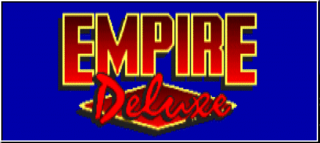
Empire is a 1977 turn-based wargame with simple rules. The game was conceived by Walter Bright starting in 1971, based on various war films and board games, notably Battle of Britain and Risk. The game was ported to many platforms in the 1970s and 1980s. Several commercial versions were also released such as Empire: Wargame of the Century, often adding basic graphics to the originally text-based user interface.
World Empire is a turn-based strategy video game, published in 1991 by Viable Software Alternatives. Risk is similar to this game in that players compete to conquer the Earth country by country through military force.

Actua Golf 2 is a sports video game developed and published by Gremlin Interactive for PlayStation and Microsoft Windows. Development of the game was underway as of August 1997, and it was released in September 1997 in Europe, and in June 1998 in North America. A Sega Saturn version was planned, but eventually cancelled.

The Golf Pro is a 1998 golf video game developed and published by Empire Interactive for Microsoft Windows. The game features professional golfer Gary Player, as well as two golf courses and a mouse-controlled golf swing method known as Mouse Drive. The game was generally praised for its graphics, but criticized for its limited camera angles. By early 1999, The Golf Pro 2 had been released in the United Kingdom.











